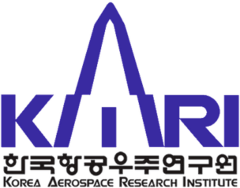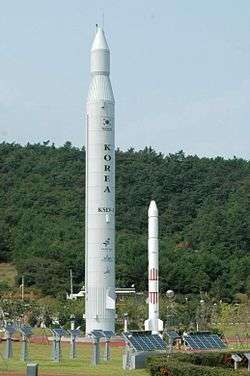Korea Aerospace Research Institute
 | |
| Acronym | KARI |
|---|---|
| Owner | Republic of Korea |
| Established | October 10, 1989 |
| Headquarters |
Daejeon, Republic of Korea |
| Primary spaceport | Naro Space Center |
| Motto | Aerius Spatium [1] |
| Administrator | Cho Gwang-rae (조광래) |
| Budget |
₩ 688.8 billion; $583 million FY2016[2] |
| Website | KARI |

The Korea Aerospace Research Institute (KARI) established in 1989, is the aeronautics and space agency of Republic of Korea. Its main laboratories are located in Daejeon, in the Daedeok Science Town. KARI's vision is to continue building upon indigenous launch capabilities, strengthen national safety and public service, industrialize satellite information and applications technology, explore the moon, and develop environmentally-friendly and highly-efficient cutting-edge aircraft and core aerospace technology. Current projects include the KSLV-2 launcher. Past projects include the 1999 Arirang-1 satellite. The agency was founded in 1989. Prior to South Korea's entry into the IAE in 1992, it focused primarily on aerospace technology.
Background
KARI began on October 10, 1989 as a national aerospace research institute with the purpose of contributing to sound development of the national economy and enhancement of people's lives through a new exploration, technological advancement, development, and dissemination in the field of aerospace science and technology.[3]
KARI began in 1989 to develop its own rockets. It produced the KSR-I and KSR-II, one and two-stage rockets in the early 1990s.
In December 1997 it began development of a LOX/kerosene rocket engine. KARI wished to develop satellite launch capability. A test launch of the KSR-III took place in 2002.
Timeline
- 1989.10 Establishment of KARI affiliated to KIMM(Korea Institute of Machinery & Materials)
- 1990.12 Cornerstone – Laying ceremony for the building of the institute
- 1992.07 Authorized as the Inspection Agency, designated by the AIDP Law
- 1992.10 Completion of construction of the research building complex
- 1993.04 Experimental Aircraft Kachi Development
- 1993.06.09 Launch of Single-stage Sounding Rocket (KSR-I)
- 1993.09 EXPO Unmanned Airship Development
- 1995. Korea launched its first communications satellite named Koreasat * 1996.11 Independent organization as KARI, an Incorporated Foundation
- 1997.03 Twin-engine composite Aircraft Development
- 1997.04 Authorized as the Type Certification Agency, designated by the Aviation Law
- 1998.06 Launch of Two-stage Sounding Rocket (KSR-II)
- 1999.01 Change of Type Certification Agency
- 1999.12 Launch of Korea Multiple Purpose Satellite (KOMPSAT I) also known as Arirang I
- 2001.01 Change of name to Korea Aerospace Research Institute
- 2001.09 Canard Aircraft Development
- 2002.11 Launch of Liquid-propellant Rocket (KSR-III)
- 2003.05 Cornerstone – laying ceremony for the Aircraft Flight Test Center
- 2003.08 Cornerstone – laying ceremony for the NARO Space Center
- 2003.09 Launch of STSAT (Science and Technology Satellite)-1[4]
- 2003.10 Multi-Purpose Stratosphere unmanned-airship Development
- 2004.10 Completion of Jeju island Tracking Station
- 2005.01 Installation of South pole ground station
- 2006.07 Launch of Korea Multi-Purpose Satellite (KOMPSAT 2) also known as Arirang II
- 2008.03 Transfer to KRCF(Korea Research Council of Fundamental Science o& Technology
- 2008.04 The first Korean astronaut
- 2008.12 Medium Aero stats Development
- 2009.06 Completion of NARO Space center
- 2009.08 The 1st launch of Korea's 1st space launch vehicle KSLV-1
- 2010.06 Launch of COMS
- 2010.06 The 2nd launch of Korea's 1st space launch vehicle KSLV-1
- 2011.11 Smart UAV Development
- 2012.05 Launch of Korea Multi-Purpose Satellite(KOMPSAT)-3
- 2012.06 Korean Utility Helicopter Surion Development
- 2013.01 The 3rd launch of Korea's 1st space launch vehicle KSLV-1
- 2013.08 Launch of Korea Multi-Purpose Satellite (KOMPSAT)-5
- 2013.11 STSAT(Science and Technology Satellite)-3 Development
- 2013.12 4KC-100 Development
- 2014.05 OPV Development
- 2014 Research on lunar exploration cooperation began
- 2015.03 Launch of Korea Multi-Purpose Satellite (KOMPSAT)-3A
- 2015.08 EAV-3 development
- 2015.12 The completion of KSLV-II’s engine combustion test facility
- 2016.12 Designated as a National Space Development Agency
Aerospace developments

KARI is also developing Unmanned Aerial Vehicles, high-altitude airships, a next-generation multi-purpose helicopter project, next- generation medium satellite, and a lunar exploration project. In addition, several satellites, including the KOMPSAT (also known as Arirang) Series, the COMS (Communication, Ocean and Meteorological Satellite), and the STSAT (Science and Technology Satellite), are developed, operated, or under development by KARI. On January 30, 2013, they launched a satellite into space from their own soil for the first time.[5]
Mission and Major Functions
- Perform basic and applied studies in aerospace technology
- Development of leading-edge technology aircraft, aircraft evaluation and testing, and support of national development projects
- Research and development of comprehensive system and core technology of aircraft, satellite, and space launch vehicle
- Support national aerospace development policy establishment, distribution, and diffusion of aerospace technology information
- Development and KSLV(Korea Launching of Space Launch Vehicles) and Operation of Space Center
- Perform government-delegated tasks and support policy development
- Development of technology for assuring aerospace safety and quality, and maintenance of legal quality certification and internationally recognized certification systems
- Establishment and support of the National Aerospace Development Policy and dissemination of knowledge on aerospace technology
- Support industries and transfer technology
- Joint utilization of testing facilities and equipment with industries and academia, and training of scientists and engineers
- Transfer of technology from research and development and provisions for commercialization support
KSLV-1 and KSLV-2
KSLV-1 launched on August 25, 2009. It was originally a cluster indigenous liquid KSR-III rockets with a solid propellant to form a multistage launcher. However, KARI experienced more difficulties than expected in SLV development, because it required much stronger propellant power than KSR-III possessed to launch a satellite into orbit.[6] After several failed attempts, KARI turned to Russia's Khrunichev Design Bureau for assistance in developing a liquid-propellant rocket engine for the KSLV-1 as well as for cooperation in the construction of the launch facility at the Naro Space Center. KSLV-1 was transformed into a two-stage launcher, 33 m high with a maximum diameter of 2.9 m. It has a mass of 140 tons at lift-off. The first stage of the launcher was derived from the Russian URM-1 (Universal Rocket Module) developed by Khrunichev. The second stage of the launcher was a solid Kick Motor developed by Korea, which includes the Inertial Navigation System; the power, control, and flight safety systems; plus the nose fairing. KSLV-1 was the most prominent project of the whole South Korean space development program and was successfully launched in late January 2013.[7] South Korea is planning to launch its next rocket KSLV-2 by year 2019. The first stage of its rocket will have 4 clustered engines, each of which will have a 75 metric ton thrust. It was announced that KARI has already developed few prototypes of a 75 metric ton thrust engine.
Korea Multiple- Purpose Satellite-3A
Korea Multiple-Purpose Satellite- 3A (KOMPSAT-3A) was launched on 25 March 2015, on a Dnepr-1 launch vehicle from the Jasny Kombarovsky site in Russia. The purpose of the KOMPSAT-3A is to enable us to take advantage of geographical information systems (GIS) in environmental, agricultural, and oceanographic sciences, and to facilitate natural hazards. The KOMPSAT-3A is equipped with two distinctive sensors, a high-resolution multi-spectral (MS) optical sensor, namely the Advanced Earth Image Sensor System-A (AEISS-A), and the Scanner Infrared Imaging System (SIIS).[8]
Smart Tilt Rotor UAV
In late 2011, KARI unveiled its tiltrotor Unmanned Aerial Vehicle (UAV) that can fly at around 400 km/hr.
Korean Lunar Exploration Program
As part of the national space promotion plan, the Korean lunar exploration program (KLEP) is to develop the first lunar probe in Korea and secure the necessary base technology for lunar exploration, such as orbit, lander, science payload, and deep space telecommunication.[9] The first stage is the development of experimental orbit lines which will be carried out to secure core technology for space exploration establishment of deeps space networked, and international joint development of payloads. The second stage, the unmanned lunar orbiter and lander are developed and launched as Korean launch vehicle. The lunar probe will be equipped with mission equipment for analyzing the environment of the moon and exploring resources such as scientific payloads, space internet, nuclear energy, and rover. Korea has secured about 70% of the core technologies needed for lunar exploration.[10]
In December 2016, KARI signed a lunar exploration technical cooperation with NASA which increased the possibility of exploration success greatly. A Korean Pathfinder Lunar Orbiter (KPLO) is to be followed by a Korean Lunar Explorer (KLE) which constitutes and orbiter and a lander unit equipped with a small rover with a mass of approximately 20 kg. The Key goals of the Korean lunar mission are the investigations of lunar geology and space environment, exploration of lunar resources, and testing of future space and planetary exploration technology which will assist in future human activities on the moon and beyond. The exploration is expected to begin in 2020.[11]
See also
References
- ↑ Latin for "Aerospace" "Archived copy". Archived from the original on 2011-09-27. Retrieved 2007-11-08.
- ↑ "기관별 경영공시 한국항공우주연구원". alio.go.kr. Archived from the original on 2016-06-24. Retrieved 2016-05-25.
- ↑ Greeting address. (2016). Korea Aerospace Research Institute. retrieved from https://www.kari.re.kr/eng/sub01_01.do
- ↑ "History". Korea Aerospace Research Institute. Retrieved 7 May 2017.
- ↑ "South Korea launches rocket weeks after NKorea". The San Diego Union-Tribune. January 30, 2013. Retrieved 2013-02-01.
- ↑ An, H. (2013). Seeking independence in space: South korea's space program (1958–2010). Quest: History Of Spaceflight, 20(2), 34–51.
- ↑ An, H. (2013). Seeking independence in space: South korea's space program (1958–2010). Quest: History Of Spaceflight, 20(2), 34–51.
- ↑ Yeom, J., Hwang, J., Jung, J., Lee, K., & Lee, C. (2017). Initial Radiometric Characteristics of KOMPSAT-3A Multispectral Imagery Using the 6S Radiative Transfer Model, Well-Known Radiometric Tarps, and MFRSR Measurements. Remote Sensing, 9(2), 1. doi:10.3390/rs9020130
- ↑ Korean lunar exploration project. (2016). Korea Aerospace Research Institute. retrieved from https://www.kari.re.kr/eng/sub03_04_01.do
- ↑ Korean lunar exploration project. (2016). Korea Aerospace Research Institute. retrieved from https://www.kari.re.kr/eng/sub03_04_01.do
- ↑ Kim, K., Wohler, C., Hyeok Ju, G., Lee, S., Rodriguez, A., Berezhnoy, A., Gasselt, S., Grumpe, A., & Aymaz, R. (2016). Korean lunar lander – Concept study for landing-site selection for lunar resource exploration. The International Archives Of The Photogrammetry, Remote Sensing And Spatial Information Sciences, Vol XLI-B4, Pp 417–423 (2016), 417. doi:10.5194/isprs-archives-XLI-B4-417-2016
External links
- KARI official website (Korean / English)
- South Korean space projects from Encyclopedia Astronautica